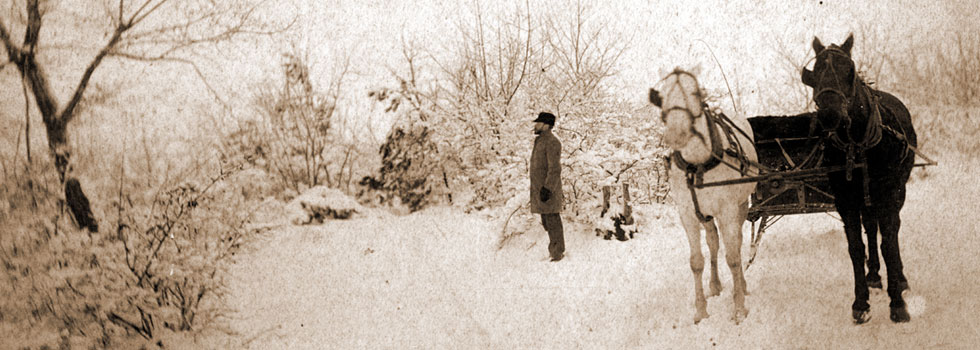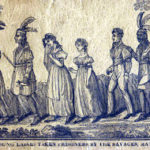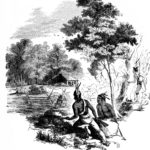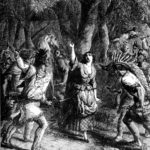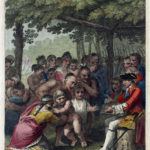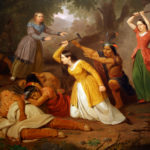My husband and I both have ancestors who were abducted by native peoples in the 18th century. My ancestors were my sixth great grandfather, Henry Boyer, his son Frederick and his daughters, Dorothea and Catherine, who were taken in a raid of their Carbon County farm in 1755. Henry was scalped and killed but his children survived. Their account is below.
On my husband’s side, his fifth great grandmother, Elizabeth Kelly, wife of Judge Robert Hanna was unlucky enough to be present at a wedding at Miller’s Blockhouse at Hannastown in Westmoreland County, PA, on July 13, 1782. In one of the last incidents of the Revolutionary War, British soldiers and Indians attacked and burned Hannastown. Elizabeth and two of her daughters were taken prisoners by the Indians. The women were taken to Montreal, held for a time as their Indian captors debated their fate, then, at the behest of a traveling Episcopal minister, were sold to British soldiers as prisoners in exchange for a keg of rum or corn whiskey, and released the following spring when peace was declared.
No written account of their captivity exists, but another woman named Elizabeth Brownlee, who was abducted with them, left something of a first hand account of her experience in a February 5, 1829, petition to the Pennsylvania State Legislature for financial support after her second husband’s death. I’ve covered her account in another blog post here.
The Boyers
In 1755, after the defeat of Braddock during the French and Indian War, the settlers began having troubles with Indians. Members of the local families, including the Boyers, erected a blockhouse for protection against attacks. But the Boyers were unlucky and were the victims of an attack. One history book describes the attack this way:
Mr. Boyer, one morning, went up to the farm with his son, Frederick, then thirteen years of age, and the other children, to attend to the crops. Mr. Boyer was plowing and Fred was hoeing potatoes, while the children were in the house or playing nearby. Without any warning they were surprised by the appearance of Indians. Mr. Boyer saw them first and shouted to Fred to run. Mr. Boyer first ran towards the house. Finding he could not reach it he ran for the creek, and was shot through the head as he reached the farther side. Fred had escaped to the wheat-field but was captured and brought back. The Indians scalped his father in his presence. They took the horses from the plow, his sisters and himself, and started for Stone Hill, in the rear of the house. After reaching the level land on the top they were joined by another party of Indians and marched northward to Canada. The sisters, in the march, were separated from their brother and were never afterward heard from. Frederick was a prisoner with the French and Indians in Canada for five years, and was then sent to Philadelphia. Nothing was ever learned of the fate of Mrs. Boyer or of the other families who remained at the block house. (Alfred Mathews and Austin N. Hungerford, History of the Counties of Lehigh and Carbon, in the Commonwealth of Pennsylvania (Philadelphia: Everts and Richards, 1884), p. 761.)
The Indians reportedly held an extreme hatred for people with red hair; Henry was a redhead. He died on June 2, 1757. The book American Boyers gives a short account of the fate of the children. “Dorothea and Catherine Boyer, were the two sisters of Frederick Beyer, and like him they were carried captives to Canada. One of the sisters married an Indian Chief, and was highly honored. A Western Paper long in possession of Charles Boyer, Fremont, Ohio, relates how the Indians erected a monument over her grave and called her the ‘White Queen.’ She came to see her brother Frederick once with two little Indian children boys, but returned to her husband saying he was very good to her, and she had promised him to return.”
Frederick remained a prisoner for five years, then was sent to Philadelphia to be exchanged. He returned to Towamensing Township, took possession of the family farm, and in 1768 married Susanna Mehrkam (1750-1815), daughter of Conrad Mehrkam, a constable living in Lower Towamensing Township.
An alternate version of the story appears in the History of Lehigh County, PA, Volume 2, p. 139.
John Jacob Beyer settled near the Lehigh Gap in Northampton county, (now Carbon) where he took up land in 1755 and carried on farming when the great incursions and massacres of the Indians arose. This land was previously owned by Charles Straub, and Boyer erected a log house for the protection of the first settlers of that vicinity. During those dangerous times he and his son Frederick were working in a field along the mountain when they were suddenly attacked by a party of Indians who violently seized the father and scalped him and took the son a captive together with a young daughter and led them to Canada. On the way in the long and difficult journey the brother and sister became separated and the sister was never afterward heard from.
Frederick Boyer, the brother, was discovered as a prisoner under the French and Indians for five years and in an exchange was sent to Philadelphia and from there soon found his way back to the Lehigh Gap. He secured the land of his father and married Susanna Mehrkam, a daughter of Conrad, who resided in that locality and subsequently took part in the Revolution; and they became the parents of eight children: John, George (born in 1768, died in i8bi at the age of 93 years, and married to Christiana Kline with whom he had three children, Adam, William and Jacob); Henry (married to Magdalena Strohl and had three children, Henry, Joseph and Reuben); Andrew (married to Mary Grunsweig and had five children, John, Andrew, Daniel, Frederick, and a daughter who became the wife of Buck); Mary, Susan, Catharine and Elizabeth.
Indian Captivity Art
Here are some graphics and artwork that illustrate Indian captives.
-
Two young women and a young man, captives, being led through the wilderness by four Sauk and Fox Indians. Source: Library of Congress
-
Native Americans Attacking the Early Settlers, etc.usf.edu Source: John Gilmary Shea, The Story of a Great Nation (New York: Gay Brothers & Company, 1886)
-
The Abduction of Jennie McRae, etc.usf.edu. Source: John Gilmary Shea, The Story of a Great Nation (New York: Gay Brothers & Company, 1886)
-
The Indians delivering up the English captives to Colonel Bouquet near his camp at the forks of Muskingum in North America in Nov 1764. From Library of Congress. Source: An historical account of the expedition against the Ohio Indians in the year 1764 / William Smith. Philadelphia, 1766.
-
Painting by Junius Brutus Stearns, “Hannah Dustin Killing the Indians”, 1847
Sources
- Charles C. Boyer, American Boyers (Kutztown, PA: Press of the Kutztown Publishing Company, 1913), p. 185. Online at https://archive.org/stream/americanboyers00inboye/americanboyers00inboye_djvu.txt.
- Alfred Mathews and Austin N. Hungerford, History of the Counties of Lehigh and Carbon, in the Commonwealth of Pennsylvania (Philadelphia: Everts and Richards, 1884), p. 761.
Find Out More
Fiction
- Dances with Wolves movie
- Indian Captive, The Story of Mary Jemison by Lois Lenski, published by Scholastic, Inc. An historically-based, but fictional account of young Mary Jemison’s abduction by Seneca Indians in 1758.
First Person Narratives
- Mary Rowlandson. The Sovereignty and Goodness of God, Together, with the Faithfulness of his Promises Displayed Being a Narrative of the Captivity and Restauration of Mrs. Mary Rowlandson (1682) (Page images of the 1811 edition at canadiana.org)
- Fanny Wiggins Kelly. Narrative of My Captivity Among the Sioux Indians (1874) Chicago: Lakeside Press, 1990. (read online at MOA)
- Lorenzo D. Oatman& Olive A. Oatman. The Captivity of the Oatman Girls among the Apache and Mohave Indians
- Mary Smith. An Affecting Narrative of the Captivity and Suffering of Mrs. Mary Smith (1815)
- Sarah L. Larimer. The Capture and the Escape or Life Among the Sioux (1870)
- Minnie Buce Carrigan, Captured by the Indians: Reminiscences of Pioneer Life in Minnesota (1903)
